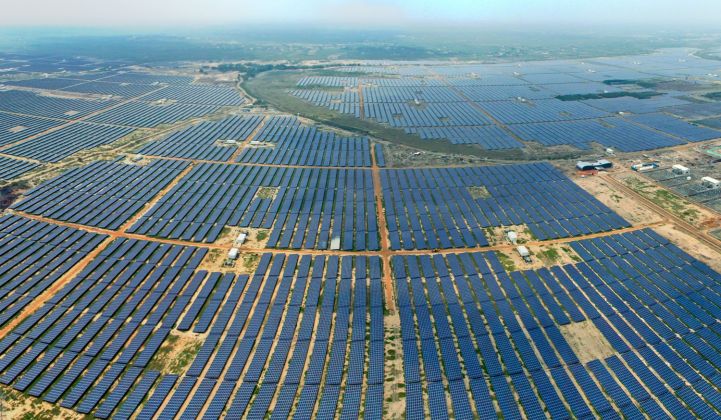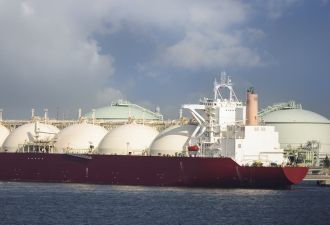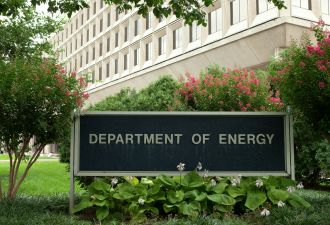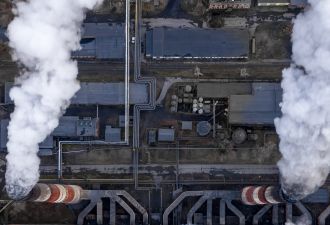Adani Green Energy, part of India's Adani Group conglomerate, will build 8 gigawatts of large-scale solar capacity worth $6 billion in India over the next five years, after winning the world's largest solar energy tender award this week.
The Solar Energy Corporation of India (SECI), a government body responsible for delivering India's 100-gigawatt solar target for 2022, selected Adani Green in a tender designed to give a boost to India's solar manufacturing sector. Adani Solar, the Adani Group's separate PV manufacturing arm, will build an additional 2 gigawatts of domestic cell and module production capacity as part of the deal, to be up and running by 2022.
The first 2 gigawatts of the solar projects will be built by 2022, with three more 2-gigawatt chunks to be added in each of the subsequent three years, the developer said. India built around 9.5 gigawatts of new solar last year, according to Wood Mackenzie, making Adani's projects a significant new tailwind for the overall market.
Adani's solar plants will be built in multiple locations, but one of the developments will be a 2-gigawatt single-site array, tying Abu Dhabi's Al Dhafra as the world's largest announced solar project.
An Adani Green spokesperson told Greentech Media that the developer will finance each 2-gigawatt portion off its own balance sheet, raising project finance as construction begins. The company will then look to refinance once the plants are operational to lower the cost of capital. Some of the projects have already undergone two to three years of development work.
The pricing of the winning projects is 2.92 rupees (3.9 cents) per kilowatt-hour.
Potential investment from France's Total?
Earlier this year Adani Green spun several gigawatts of operational solar assets into a new company, with French energy major Total taking a 50 percent stake in the new venture for $510 million.
On a conference call this week, Adani Group chairman Gautam Adani said that Total is "very much interested" in expanding its partnership with Adani Green and that several other foreign investors are also in talks with the company.
“[Adani Green] is always looking for ways to further reduce its costs of capital and to work with other energy majors and traditional investors as a path to facilitating the company's continued rapid growth,” the spokesperson told GTM in an email.
The Adani Group runs a diverse range of businesses from logistics and ports to aerospace and coal mining. The week's win takes Adani Green's pipeline of built, under-construction or contracted solar projects to 15 gigawatts. The developer, among India's largest renewables players, is targeting 25 gigawatts of installed solar capacity by 2025.
Avoiding the financing pitfalls for Indian solar projects
Despite the government's big ambitions, confidence in India's solar market has been shaky in recent years. The government's goal of 175 gigawatts of renewables by 2022, including 100 gigawatts of solar, is widely seen as unrealistic. India had around 36 gigawatts of installed solar at the end of 2019, according to Wood Mackenzie.
India has failed to build up a local PV manufacturing sector capable of competing with China. In the development world, the country's complex patchwork of regional and national tenders, differing local content rules and often unreliable offtakers have created instability and driven up the cost of finance.
As solar prices in Indian tenders fell to very low levels, financially struggling local power distribution companies, known as discoms, began pushing to renegotiate some older, higher-priced contracts — further denting investor confidence. And all that was happening before the coronavirus pandemic hit.
SECI's latest tender award avoids some of these pitfalls, however. For starters, the Indian government recently said it would inject 900 billion rupees ($11.9 billion) of liquidity into the country's discoms.
“Coronavirus will likely make the discoms' financial health worse, but the impact will be reduced by the government infusing liquidity into the power sector,” said Rishab Shrestha, solar analyst at Wood Mackenzie Power & Renewables. “These are large projects with contracted revenues, and it’s difficult for me to imagine SECI backing out of contracts. Historically, it was the investors that were pessimistic rather than the government.”
“SECI enjoys the full support of its 100 percent owner, the government of India,” Adani Green's spokesperson said, noting that ratings firm Fitch has this week given SECI and state power company NTPC a clean bill of health.
Can India finally kick-start its solar manufacturing sector?
Bidders in the 8-gigawatt tender had to commit to building local solar manufacturing capacity. Whether Adani's commitment gives the country a sustainable boost remains to be seen.
“SECI has made several attempts to kick-start the domestic manufacturing process through tenders but has failed to attract sufficient investors," said WoodMac's Shrestha. "The cost-competitiveness of domestic manufactured modules against Chinese imports was, and remains, the key hurdle."
Despite this, Shrestha said the government has shown that it's determined to establish a local renewables supply chain, even if that means higher costs for projects. “Focusing on localizing the supply chain also offers significant job opportunities for the growing Indian workforce,” added Shrestha.
Adani expects the manufacturing, construction and deployment of its full 8 gigawatts of solar to create 400,000 jobs.
If nothing else, the sheer size of Adani's tender win this week gives it an advantage as it moves to scale up its local solar manufacturing.
“Logistics, utilities [and] bills of materials are driving the cost of Indian modules higher than that of China, so with this massive capacity, they’ll be able to leverage scale for more competitive pricing,” said Shrestha.




